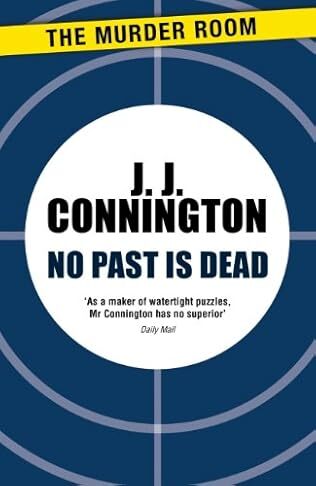No Past Is Dead

A review of No Past is Dead by J J Connington – 25 0401
It is a while since I have read a novel by J J Connington. No Past is Dead is a later one, the fifteenth in his Sir Clifford Driffield series and originally published in 1942, and is really rather good. There is more than a little touch of the exotic in the story and a fabulous alibi which takes all of Driffield’s ingenuity and the resources of the Yard to crack.
The story starts with Driffield hosting a dinner at which his faithful Watson figure, Wendover “the Squire”, and a journalist, Peter Diamond are present. Diamond regales the pair with an account of the extraordinary goings on at the Hernshaw Thirteen Club, at which its leader, Ambrose Brenthurst, goes out of his way to defy almost every superstition about bad luck. For the student of folk lore it is a fascinating resume of what acts are guaranteed to bring with them ill fortune.
Brenthurst is also a moneylender with a particular penchant for ensnaring young women, one of whom is Diana Teramond, who invites him to her house, Fountain Court, at 1 am. There is an argument, and Brenthurst’s body is found on the road and is found by a would-be housebreaker in the process of being devoured by a cheetah. Miss Teramond, a second-rate actress on the musical hall stage, incorporated a cheetah into her act and then subsequently kept it as a pet, rather like Josephine Baker.
Wendover only plays a bookend in this story, in at the start and there to receive Driffield’s reconstruction of what happened at the end, his usual role of stating the bleedin’ obvious and getting old of the wrong end of the stick being played by Inspector Sandrock. Sandrock is too eager to take evidence at its face value and construct fanciful theories, much to Driffield’s amusement and irritation. Driffield’s style is to take a more measured approach at the risk of seeming haughty and condescending to his underlings. For a Chief Constable he takes a surprisingly active part in investigations.
As well as a man-devouring cheetah, we have suspicions of voodoo practices, complete with obligatory racist comments about the denizens of Haiti, a jewel that is cursed, and to add to the fun of the fair the gardeners are stealing some of the apples to sell clandestinely at the time of the murder as well as a housebreaker about to case the joint, and the Faircrosses, mother and son, lurking on the scene. Just for good measure, there is another murder, that of Mrs Brenthurst’s maid, another case of someone who knows too much. At one point there are as many potential suspects in the grounds of Fountain Court as you would expect to find at Picadilly Circus at that time of the night.
However, the main suspects become clearer as the narrative progresses. The keys to the mystery are a complicated family tree, a shadowy figure by the name of and a Christian name that can equally apply to a female as well as a male, a point that passed me by in this instance, and a signed affidavit all the way from San Francisco. It is fascinating to note that the investigation was effectively stalled for several weeks as this crucial piece of information made its way through the transatlantic postal system. With this to hand, the mystery is solved.
It would not be a Connington novel without some didacticism peeping through. Crucial to the motive for the crime is an understanding of the Birkenhead Act of 1925 and in the solving of it the use of Hudson’s method, an advanced form of test for blood which was introduced in 1935. Driffield, of course, not only knows about the test but has practiced with it so he casn use it with ease.
The bones of the plot are based on an 1890 case in France where a Madame Achet killed a notary by the name of Lépine, to whom she owed 17,000 francs, in the garden after a struggle, in self-defence, she claimed. With these few essentials Connington weaves an altogether different story and excellent it is too.



